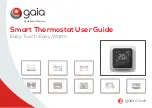
Honeywell
y
Subject to change
EN2H-2125GE25 R1208
50036794
-001
VTL120
RadPlan Radiator Thermostat and Lockshield set
Installation and User Instruction
1. Additional Information
2. Notes and Safety instructions
These products are approved to the European CEN standard EN215,
which supersedes BS 6284.
Whilst Honeywell takes all reasonable practical steps to design and
manufacture its products to comply with the requirements of the Health
and Safety at Work Act 1974 all products must be properly used and
purchasers are reminded that their obligations under the Act are to
ensure that the installation and operation of such products at a place of
work should be safe and without risk to health.
Honeywell reserves the right at any time and without notice to change
any product or any information contained in this publication.
2.1. Check list
• Check all connections for securing and leaks.
• Use clean pipework, free from swarf.
• Consider the use of an automatic by-pass valve
(e.g. Honeywell DU145) to ensure the specification is adherded to.
• Don’t allow heat from blow torch onto body.
• Don’t install the valve in a position which is subject to draughts, sun
radiation or behind curtains.
• Don’t overtighten the head/body connection, as the insulating sleeve
may become damaged.
3. Location
The thermostat can be fitted in any orientation with the flow through the
body in either direction.
4. Technical Data
Maximum working pressure
10 bar (140 psi)
Closing time
20 minutes
To ensure that the valve will thermostatically close the differential pres-
sure must not exceed 1.0 bar.
Maximum differential pressure to ensure reliable and quiet operation is
0.2 bar.
5. Component parts
1. Wheelhead
2. Decorators Cap
3. Valve body
4. Tail piece
5. Olive (2x)
6. Nut (2x)
7. Lockshield valve
6. Installation
6.1. Fitting - valve con-
nections
1. Fit the connection fittings
to the valve.
2. Cut copper tube to entry depth of 10 mm.
What is a thermostatic radiator valve (TRV)?
..an explanation for householders
TRVs sense the air temperature around them and
regulate the flow of water through the radiator which they are fitted
to. They do not control the boiler.
TRVs sense the air temperature around them and regulate the flow
of water through the radiator which they are fitted to. They do not
control the boiler.
They should be set at a level that gives you the room temperature
you want. These settings may have to be different in each room,
and should set the TRVs to suit each room an then leave them to
do their job.
Turning a TRV to a higher setting will not make the room heat up
any faster. How quickly the room heats up depends on the boiler
size and setting, and the radiator size. Turning the TRV to a lower
setting will result in the room beiing controlled at a lower tempera-
ture, and saves energy.
TRVs need a free flow of air to sense the temperature, sp they must
not be covered by curtains or blocked by furniture.
TRVs cannot turn off the boiler when the whole house is warm. To
do that, you will need a room thermostat as well. The radiator in the
room with the romm thermostat should normally have a TRV, but, if
it does, keep the TRV on the maximum setting and adjust the room
thermostat as explained with the instructions.
7
5
6
4
5
3
1
2
6
10mm
OBJ_DOKU-2473-001.fm Seite 1 Dienstag, 16. Dezember 2008 8:43 08




















